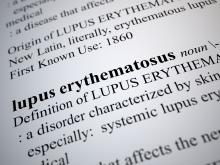User login
, according to investigators.
In terms of identifying clinically significant changes, the Systemic Lupus Erythematosus Disease Activity Score (SLE-DAS) was superior to the SLE Disease Activity Index 2000 (SLEDAI-2K), said the authors of a longitudinal cohort study comparing the two instruments.
The SLE-DAS maintained high specificity compared with the SLEDAI-2K and had a similar clinical workup time requirement, according to Diogo Jesus, MD, of the rheumatology department at Centro Hospitalar e Universitário de Coimbra, Portugal, and his colleagues.
“Such a performance can have major implications in the interpretation of clinical trials applying the disease activity as the primary endpoint, and in daily clinical practice, where SLE-DAS could provide robust guidance for treatment in the individual patient,” Dr. Jesus and his coauthors wrote in Annals of the Rheumatic Diseases.
The longitudinal cohort study by Dr. Jesus and his colleagues included 520 patients with SLE from tertiary care centers in Coimbra, Portugal, and Padova, Italy. These included a derivation cohort of 324 patients and an external validation cohort of 196 patients (the Padova Lupus Cohort).
A cutoff value of 1.72 for change in the 17-item SLE-DAS had significantly higher sensitivities to detect a clinical meaningful improvement in both the derivation (82.1%) and external validation (89.5%) cohorts, compared with a cutoff value of 4 or higher in the SLEDAI-2K at 44.8% and 47.4%, respectively, the investigators reported. Likewise, ability to detect clinically meaningful worsening was significantly higher with SLE-DAS, with sensitivities of 93.1% in the derivation cohort and 95.5% in the external validation group versus a respective 46.6% and 59.1% for SLEDAI-2K. Both clinical improvement and worsening were defined by a change in the Physician Global Assessment score of 0.3 or more.
Specificity was high for both instruments, with values around 98%-99% in both cohorts for clinically meaningful worsening and about 97%-100% for clinically meaningful improvement, the report shows.
Further analyses showed that disease activity tracked over time with SLE-DAS had a higher predictive value for damage accrual versus the SLEDAI-2K, according to the investigators.
The SLE-DAS formula, published in the journal by Dr. Jesus and his colleagues, includes a total of 17 weighted and mostly binary variables: presence or absence of alopecia, arthritis, cardiac/pulmonary involvement, generalized cutaneous rash, hemolytic anemia, hypocomplementemia, increased anti-dsDNA levels, leukopenia, localized cutaneous rash, mucocutaneous vasculitis, mucosal ulcers, myositis, neuropsychiatric involvement, proteinuria, serositis, systemic vasculitis, and thrombocytopenia.
Next, the researchers plan to define SLE-DAS cutoff values for remission, low disease activity, and moderate or high disease activity. An online calculator is also in the works, they said.
Dr. Jesus and his coauthors did not report any outside funding for the study and said they had no competing interests related to their research.
SOURCE: Jesus D et al. Ann Rheum Dis. 2019 Jan 9. doi: 10.1136/annrheumdis-2018-214502.
, according to investigators.
In terms of identifying clinically significant changes, the Systemic Lupus Erythematosus Disease Activity Score (SLE-DAS) was superior to the SLE Disease Activity Index 2000 (SLEDAI-2K), said the authors of a longitudinal cohort study comparing the two instruments.
The SLE-DAS maintained high specificity compared with the SLEDAI-2K and had a similar clinical workup time requirement, according to Diogo Jesus, MD, of the rheumatology department at Centro Hospitalar e Universitário de Coimbra, Portugal, and his colleagues.
“Such a performance can have major implications in the interpretation of clinical trials applying the disease activity as the primary endpoint, and in daily clinical practice, where SLE-DAS could provide robust guidance for treatment in the individual patient,” Dr. Jesus and his coauthors wrote in Annals of the Rheumatic Diseases.
The longitudinal cohort study by Dr. Jesus and his colleagues included 520 patients with SLE from tertiary care centers in Coimbra, Portugal, and Padova, Italy. These included a derivation cohort of 324 patients and an external validation cohort of 196 patients (the Padova Lupus Cohort).
A cutoff value of 1.72 for change in the 17-item SLE-DAS had significantly higher sensitivities to detect a clinical meaningful improvement in both the derivation (82.1%) and external validation (89.5%) cohorts, compared with a cutoff value of 4 or higher in the SLEDAI-2K at 44.8% and 47.4%, respectively, the investigators reported. Likewise, ability to detect clinically meaningful worsening was significantly higher with SLE-DAS, with sensitivities of 93.1% in the derivation cohort and 95.5% in the external validation group versus a respective 46.6% and 59.1% for SLEDAI-2K. Both clinical improvement and worsening were defined by a change in the Physician Global Assessment score of 0.3 or more.
Specificity was high for both instruments, with values around 98%-99% in both cohorts for clinically meaningful worsening and about 97%-100% for clinically meaningful improvement, the report shows.
Further analyses showed that disease activity tracked over time with SLE-DAS had a higher predictive value for damage accrual versus the SLEDAI-2K, according to the investigators.
The SLE-DAS formula, published in the journal by Dr. Jesus and his colleagues, includes a total of 17 weighted and mostly binary variables: presence or absence of alopecia, arthritis, cardiac/pulmonary involvement, generalized cutaneous rash, hemolytic anemia, hypocomplementemia, increased anti-dsDNA levels, leukopenia, localized cutaneous rash, mucocutaneous vasculitis, mucosal ulcers, myositis, neuropsychiatric involvement, proteinuria, serositis, systemic vasculitis, and thrombocytopenia.
Next, the researchers plan to define SLE-DAS cutoff values for remission, low disease activity, and moderate or high disease activity. An online calculator is also in the works, they said.
Dr. Jesus and his coauthors did not report any outside funding for the study and said they had no competing interests related to their research.
SOURCE: Jesus D et al. Ann Rheum Dis. 2019 Jan 9. doi: 10.1136/annrheumdis-2018-214502.
, according to investigators.
In terms of identifying clinically significant changes, the Systemic Lupus Erythematosus Disease Activity Score (SLE-DAS) was superior to the SLE Disease Activity Index 2000 (SLEDAI-2K), said the authors of a longitudinal cohort study comparing the two instruments.
The SLE-DAS maintained high specificity compared with the SLEDAI-2K and had a similar clinical workup time requirement, according to Diogo Jesus, MD, of the rheumatology department at Centro Hospitalar e Universitário de Coimbra, Portugal, and his colleagues.
“Such a performance can have major implications in the interpretation of clinical trials applying the disease activity as the primary endpoint, and in daily clinical practice, where SLE-DAS could provide robust guidance for treatment in the individual patient,” Dr. Jesus and his coauthors wrote in Annals of the Rheumatic Diseases.
The longitudinal cohort study by Dr. Jesus and his colleagues included 520 patients with SLE from tertiary care centers in Coimbra, Portugal, and Padova, Italy. These included a derivation cohort of 324 patients and an external validation cohort of 196 patients (the Padova Lupus Cohort).
A cutoff value of 1.72 for change in the 17-item SLE-DAS had significantly higher sensitivities to detect a clinical meaningful improvement in both the derivation (82.1%) and external validation (89.5%) cohorts, compared with a cutoff value of 4 or higher in the SLEDAI-2K at 44.8% and 47.4%, respectively, the investigators reported. Likewise, ability to detect clinically meaningful worsening was significantly higher with SLE-DAS, with sensitivities of 93.1% in the derivation cohort and 95.5% in the external validation group versus a respective 46.6% and 59.1% for SLEDAI-2K. Both clinical improvement and worsening were defined by a change in the Physician Global Assessment score of 0.3 or more.
Specificity was high for both instruments, with values around 98%-99% in both cohorts for clinically meaningful worsening and about 97%-100% for clinically meaningful improvement, the report shows.
Further analyses showed that disease activity tracked over time with SLE-DAS had a higher predictive value for damage accrual versus the SLEDAI-2K, according to the investigators.
The SLE-DAS formula, published in the journal by Dr. Jesus and his colleagues, includes a total of 17 weighted and mostly binary variables: presence or absence of alopecia, arthritis, cardiac/pulmonary involvement, generalized cutaneous rash, hemolytic anemia, hypocomplementemia, increased anti-dsDNA levels, leukopenia, localized cutaneous rash, mucocutaneous vasculitis, mucosal ulcers, myositis, neuropsychiatric involvement, proteinuria, serositis, systemic vasculitis, and thrombocytopenia.
Next, the researchers plan to define SLE-DAS cutoff values for remission, low disease activity, and moderate or high disease activity. An online calculator is also in the works, they said.
Dr. Jesus and his coauthors did not report any outside funding for the study and said they had no competing interests related to their research.
SOURCE: Jesus D et al. Ann Rheum Dis. 2019 Jan 9. doi: 10.1136/annrheumdis-2018-214502.
FROM ANNALS OF THE RHEUMATIC DISEASES
Key clinical point: The Systemic Lupus Erythematosus Disease Activity Score (SLE-DAS) had better performance in detecting clinically significant changes, compared with the commonly used SLE Disease Activity Index 2000 (SLEDAI-2K).
Major finding: In a validation cohort, the SLE-DAS (vs. SLEDAI-2K) had a significantly higher sensitivity to detect a clinical meaningful improvement (89.5% vs. 47.4%) and clinically meaningful worsening (95.5% vs. 59.1%), with comparably high specificity for both tools.
Study details: Longitudinal cohort study including 520 patients with SLE from two tertiary care centers.
Disclosures: The study authors did not report any outside funding for the study and said they had no competing interests related to the research.
Source: Jesus D et al. Ann Rheum Dis. 2019 Jan 9. doi: 10.1136/annrheumdis-2018-214502.

